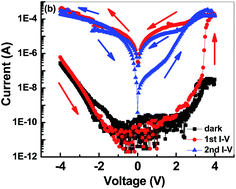Light assisted irreversible resistive switching in ultra thin hafnium oxide
Abstract
An ultra thin film (∼5 nm) high-k Hafnium oxide dielectric, grown on a doped p-Si(100) substrate by the atomic layer deposition technique has been investigated for resistive and capacitive switching with and without illumination of light. As grown samples illustrate small non-switching leakage current under high applied electric fields and probe frequencies and trap charge assisted counter-clockwise capacitance–voltage behavior. A unique resistance switching was observed under illumination of 15–60 mW light. In the first cycle, the light assisted switching provide a 104 : 1 resistance ratio, which diminishes in the next cycle onward, which may be due to irreversible charge injection in the oxide layers. The band offset and band match-up energy diagram for the charge carriers responsible for resistive switching and charge trapping near the interface have been demonstrated under the application of a bias electric field and light.


 Please wait while we load your content...
Please wait while we load your content...